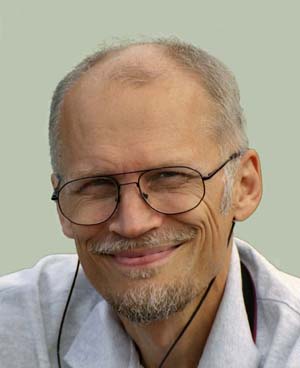



IN MEMORIAM:
Professor Matti Karjalainen - a pioneer in audio and acoustics
Professor Matti Karjalainen died on May 30, 2010, at his home in Espoo, Finland, after a prolonged illness. As the eldest of two children, he was born on the 2nd of April in 1946 to a farming family on a small plot of land in the village of Halttula in Hankasalmi. His elementary education began at the local village school while his middle and high-school studies were carried out at nearby Lievestuore from which he graduated in 1965.
Matti began to be interested in electrical motors and radios after finishing elementary school. At the end of the 1950s the first transistors came on the market, and like many other school boys of that time, he gained a new hobby: building pocket radios. The 1950s gave birth to pop and rock music and Matti followed the new hits on Radio Luxembourg as other youth did. In the beginning of the 1960s he received his first acoustic guitar and harmonica. Matti played music himself and was an active listener for a wide range of genres and musical events.
Studies at the Tampere University of Technology (TTKK)
In the autumn of 1965 Matti began his studies at TTKK. The grades that he received on his university entrance examinations would have sufficed for him to enter the Helsinki University of Technology (TKK) but Matti felt that Tampere would make for a more comfortable place of study.
TTKK had just initiated operations as an extension of TKK. One of the responsibilities of the first class of students was to start up student union activities on the campus. The engineering students founded a radio club of which Matti became a member and he also earned his amateur radio technical class license at the same time. For the engineering students he designed powerful sound reproduction equipment during his spare time. By the autumn of 1968 Mattiʼs studies had progressed so far that he obtained his first job as a course assistant at the university. After completing his Masters thesis in 1972 he entered Finnish military service and was stationed at Riihimäki with the Communications Regiment.
1973 was a decisive year for Mattiʼs career. During a weekend in August he and Unto Laine were performing experiments with electronic music in the electronics laboratory of TTKK. While experimenting with analog resonance circuits they produced sounds that were similar to a human voice. They demonstrated this to the department head, professor Boris Segerståhl, who then asked if this could be developed into a real speech synthesizer. After applying for a grant the Finnish Academy funded a small- scale study for them and the spring of 1974 turned out to be the starting point of speech technology research in Finland. That year was filled with intensive development work and by the end of December the developed synthesizer was able to request – with its own voice – for more funding from the Academy!
In 1974 Matti was selected to be the head electronics assistant and during the same year he completed his Licentiate in Technology degree that dealt with power electronics. Two years later in 1976 Matti married Raija Vappu Valtari. A year later their son was born and then two years later their daughter.
The synthesis of the human voice
Matti Karjalainen successfully defended his doctoral dissertation on speech synthesis in October of 1978. Research into speech synthesis and its applications continued in Tampere up to 1981. During this time the Synte2 and Synte3 speech synthesizers were constructed. Synte2 created much international interest since it was the first portable, unlimited vocabulary, speech synthesizer that had ever been built for any language. What made this technological breakthrough possible was the introduction of microprocessors, which were being applied to different problem domains.
ʻSpeaking machinesʼ created quite a sensation worldwide when they first appeared and they were also covered quite extensively in Finland by newspapers, radio, and television documentaries.
In 1980 Matti and his family moved to Espoo since he had been appointed as an associate professor at TKKʼs department of electrical engineering. When Matti started at the acoustics laboratory the available resources were meager: there was only one course assistantʼs position (waiting to be filled) and one laboratory technician available – so nearly everything else had to be started from scratch. Little by little research projects began to spring up, resources started to increase, and the number of students attending his courses began to grow.
Under Mattiʼs direction the development of research specializing in speech technology at Finnish universities started to emerge, and this occurred much earlier, before the mainstream emergence of Finlandʼs current speech industry. Along with the birth of mobile digital telephone technology in the early 1990s, strong growth in research created new knowhow that was being applied to industry, e.g., for Nokiaʼs needs. The research in speech technology that Matti ushered in has continued to be actively pursued at the newly formed Aalto University School of Science and Technology.
While working on speech synthesis, Matti noted that no conventional signal analyzer existed that could measure the quality of the generated speech. He realized that this void needed to be filled by developing computational models that were based on the human ear and hearing system. It is algorithms like the standardized PEAQ (Perceptual Evaluation of Audio Quality) and lossy audio coding algorithms, such as MP3, that are based on psychoacoustic models. Matti continued research in psychoacoustics up to the end of his career and applied the principles widely in different areas of sound technology. He published this research and a textbook (in Finnish) that is still in use.
Synthesis of musical instrument sounds
Matti was also interested in the acoustics of musical instruments and the accurate synthesis of their sounds. The acoustics of the guitar was studied and modeled, and along with that, the first scientific investigation into the acoustical properties of the Finnish zither ("kantele") was published. In that paper it was determined what physical properties of the zither create its beautifully bright tonal structure. With these studies a new line of research formed that has expanded over time to cover audio effects and the interaction between humans and machines using the audio channel.
Matti also initiated the modeling of spatial sound, its recording, and research into its perception at the beginning of the 1990s from which two research groups were formed and continue to perform research to this day.
An inspiring and lenient teacher
Alongside his research Matti Karjalainen, through his work as a teacher, taught and parented many of the acousticians and sound technologists in Finland. In Otaniemi he introduced the first university level courses in Finland that covered communication acoustics, the programming of signal processors, and speech processing – courses that are still being taught today. Over the decades hundreds of students have journeyed through these courses so that industry has acquired engineers well versed in sound technology. This has also helped to fulfill the needs of the Finnish mobile phone industry.
While teaching Matti stressed the importance of learning the principles of learning ("learning to learn"). He also found it important that course material cover a sufficiently broad area so that it would form a foundation on which different work scenarios and new research fields could be supported. During his professorship he supervised over 20 doctoral dissertations and 100 M.Sc. theses.
Over the decades Matti Karjalainenʼs persevering work and sustained interest towards acoustic and psychoacoustic phenomena has borne fruit. Matti as a leader had a heart of gold and let everyone come to him as they were, humbly nurturing and ensuring that every new student could grow and develop.
The genuine enthusiasm that Matti exhibited towards research was infectious and caught on to other researchers. The Acoustics Laboratory grew explosively near the end of the 1990s so that three new professorships in speech and audio signal processing were formed and the number of personnel rose to about 40. The current unit has been integrated into the Department of Signal Processing and Acoustics which is part of Aalto Universityʼs Faculty of Electronics, Communications and Automation.
International recognition
Matti built up a wide base of international contacts. Already in the mid-1970ʼs he began actively participating in international conferences and visited both commercial and academic research institutes. For example, early on he founded good relations with Stanford University that were later strengthened by him spending a sabbatical year in Palo Alto in 1995.
Matti Karjalainen received several awards in recognition of his substantial effort throughout his life towards acoustics and technology related to audio. In 1999 he was promoted to the level of Fellow in the Audio Engineering Society (AES) and in 2006 received their silver medal. For his influential scientific work on perceptually modeling audio signals he was promoted to the level of an IEEE Fellow in December of 2009.
Matti Karjalainen trust
When Matti turned 60 and was already aware of his illness, he established a trust bearing his name whose objective was to support research in acoustics and especially help support gifted young students. Mattiʼs message was that if a student was motivated and gifted then economic reasons should not be a hindrance to pursue a scientific career and make progress within it.
Matti Karjalainenʼs own life is an outstanding example of this. The fruit of his creativity, diligence, and thinking will continue to be appreciated and enjoyed for a long time in Finnish and international scientific circles, and will be of benefit to his colleagues, new student generations, and all of society.
Matti Karjalainenʼs urn will be quietly laid to rest in Gräsaʼs cemetery with family present. His lifeʼs work can be remembered by a donation to the Matti Karjalainen trust:
Account owner: Akustinen Seura (Acoustical Society of Finland)
Account number: Nordea IBAN FI9810113000205947
Message: Gift to the Matti Karjalainen trust
The research groups in acoustics and sound processing will deeply miss their former leader, friend, and exemplary figure.
esittely | introduction | contact info | teaching | research | publications | current news | demonstrations | software | links | feedback | intranet | finder
http://www.acoustics.hut.fi/notice/in_memoriam_matti_karjalainen-en.html
Modified: 15.06.2010
< Feedback >